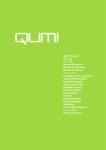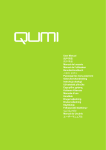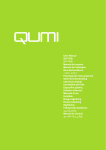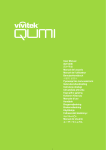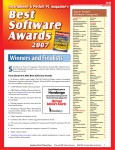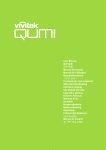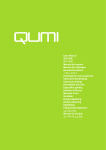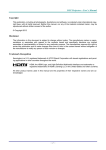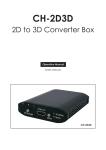Download Vivitek Q7 Plus
Transcript
Preface Copyright ©2014 Vivitek Corporation. is a trademark of Vivitek Corporation. Other trademarks are the properties of their respective owners. Values, weights and dimensions are approximate. Specifications are subject to change without prior notice. Disclaimer The information in this document is subject to change without notice. The manufacturer makes no representations or warranties with respect to the contents hereof and specifically disclaims any implied warranties of merchantability or fitness for any particular purpose. The manufacturer reserves the right to revise this publication and to make changes from time to time in the content hereof without obligation of the manufacturer to notify any person of such revision or changes. Trademark Recognition Kensington is a U.S. registered trademark of ACCO Brand Corporation with issued registrations and pending applications in other countries throughout the world. HDMI, the HDMI Logo, and High-Definition Multimedia Interface are trademarks or registered trademarks of HDMI Licensing LLC in the United States and other countries. MHL, the MHL logo, and Mobile High-Definition Link are trademarks or registered trademarks of MHL licensing, LLC. All other product names used in this manual are the properties of their respective owners and are acknowledged. Ver. : 1 ii Important Safety Information ! Important: It is strongly recommended that you read this section carefully before using the Qumi. These safety and usage instructions that will make sure you enjoy many years of safe use of the Qumi. Keep this manual for future reference. Symbols Used Warning symbols are used on the unit and in this manual to alert you of hazardous situations. The following styles are used in this manual to alert you to important information. Note: Provides additional information on the topic at hand. ! Important: Provides additional information that should not be overlooked. ! Caution: Alerts you to situations that may damage the unit. ! Warning: Alerts you to situations that may damage the unit, create a hazardous environment, or cause personal injury. Throughout this manual, component parts and items in the OSD (On-Screen Display) menus are denoted in bold font as in this example: “Press the Menu button on the remote control to open the Main menu.” General Safety Information • Do not open the unit case. There are no user-serviceable parts in the unit. For servicing, contact qualified service personnel. • Follow all warnings and cautions in this manual and on the unit case. • The projection light source is extremely bright by design. To avoid damage to eyes, do not look into the lens when the LED illumination is on. • Do not place the unit on an unstable surface or stand. • Avoid using the system near water, in direct sunlight, or near a heating device. • Do not place heavy objects such as books or bags on the unit. iii Qumi Installation Notice • Allow at least a 50cm clearance around the exhaust vent. Minimum 100mm Minimum 500mm • Make sure that the intake vents do not recycle hot air from the exhaust vent. • When operating the Qumi in an enclosed space, make sure that the surrounding air temperature within the enclosure does not exceed operating temperature while the Qumi is running, and the air intake and exhaust vents are unobstructed. • All enclosures should pass a certified thermal evaluation to make sure that the Qumi does not recycle exhaust air, as this may cause the device to shutdown even if the enclosure temperature is with the acceptable operating temperature range. ! Caution: Avoid using the Qumi in dusty environments. iv Power Safety • Only use the supplied power cord. • Do not place anything on the cord. Place the cord where it will not be in the way of foot traffic. • Remove the battery from the remote control when storing or not in use for a prolonged period. Cleaning the Qumi • Unplug the cord before cleaning. See Cleaning the Qumi on page 47. Note: The Qumi will be warm after usage. Allow Qumi to cool down before storing in a compartment. Regulatory Warnings Before installing and using the Qumi, read the regulatory notices in the Regulatory Compliance on page 59. Symbol Explanations DISPOSAL: Do not use household or municipal waste collection services for disposal of electrical and electronic equipment. EU countries require the use of separate recycling collection services. Main Features • Lightweight unit, easy to pack away and transport. • Compatible with all major video standards including NTSC, PAL, and SECAM. • A high brightness rating allows for presentations in daylight or in lit rooms. • Supports data resolution up to UXGA at 16.7 million colors to deliver crisp, clear images. • Flexible setup allows for front, rear, ceiling and rear ceiling projections. • Line-of-vision projections remain square, with advanced keystone correction for angled projections. • Input source automatically detected. About this manual This manual is intended for end users and describes how to install and operate the Qumi. Wherever possible, relevant information—such as an illustration and its description—has been kept on one page. This printer-friendly format is both for your convenience and to help save paper, thereby protecting the environment. It is suggested that you only print sections that are relevant to your needs. v Table of Contents Preface................................................................................................................... ii Chapter 1 At a Glance................................................................. 1 Overview................................................................................................................. 1 Standard Accessories............................................................................................. 3 Optional Accessories.............................................................................................. 3 Remote Control....................................................................................................... 4 Qumi and Remote Control Buttons......................................................................... 4 Media Player Screen.............................................................................................. 5 Chapter 2 Getting Started........................................................... 6 What You Need....................................................................................................... 6 Setting Up Qumi..................................................................................................... 7 Setting Up the Remote Control............................................................................. 13 Chapter 3 Qumi Media Suite..................................................... 14 Overview............................................................................................................... 14 Music.................................................................................................................... 15 Movies.................................................................................................................. 17 Photos................................................................................................................... 18 Office Viewer......................................................................................................... 19 Wifi........................................................................................................................ 20 Web browser......................................................................................................... 23 Wifi Display........................................................................................................... 24 Settings................................................................................................................. 25 Chapter 4 On-Screen Display (OSD) Settings........................ 27 OSD Menu Controls.............................................................................................. 27 Setting the OSD Language................................................................................... 28 OSD Menu Overview............................................................................................ 29 Image Menu.......................................................................................................... 32 Settings 1 Menu.................................................................................................... 36 Settings 2 Menu.................................................................................................... 41 Chapter 5 Taking Care of Your Qumi....................................... 47 Cleaning the Qumi................................................................................................ 47 Cleaning the Lens................................................................................................. 47 Troubleshooting.................................................................................................... 48 Vivitek Support Site............................................................................................... 52 Specifications........................................................................................................ 53 Projection Distance vs. Projection Size................................................................ 54 Projection Distance and Size Table...................................................................... 54 Timing Mode Table................................................................................................ 55 2D to 3D Timing Table........................................................................................... 56 3D Timing Table.................................................................................................... 57 Qumi Dimensions................................................................................................. 58 Regulatory Compliance........................................................................................ 59 Safety Certifications.............................................................................................. 59 Disposal and Recycling........................................................................................ 59 vi Chapter 1 At a Glance Overview Front/Top/Right View Keypad See Keypad - On-Screen Display (OSD) buttons Cooling Vent Zoom / Focus ring Do not cover Zoom / Focus the projected image Cooling Vent Lens Do not cover Projection Lens Keypad Up Cursor Navigate and change settings in the OSD Return Return the previous OSD menu Menu Enter Cursor Open and exit the OSD Change settings in the OSD Left Cursor Navigate and change settings in the OSD Down Cursor Navigate and change settings in the OSD Power Switch Turn on/off the Qumi Right Cursor Navigate and change settings in the OSD 1 Rear/Top/Left View AC In Connect the supplied power cord USB Connect an USB Flash Disc HDMI 1/ MHL Audio Out Connect a HDMI / MHL cable from a HDMI / MHL device Connect an audio cable to speakers or headphones IR Receiver Audio in (L&R) Receive IR signal from the remote control Connect the Audio in (L&R) cable from an audio device HDMI 2 Connect a HDMI cable from a HDMI device Video Connect the video cable from a video device VGA Connect the VGA cable from a VGA device Bottom View Tilt adjuster Rotate adjuster lever to adjust angle position Tripod Connecting Slot Tripod not included Cooling Vent Rubber Foot Pad Do not cover Stability and maintain cooling ventilation 2 Standard Accessories Along with the Qumi, the following accessories are included: Remote Control (With one 3V CR2025 battery) Standard HDMI Cable VGA Cable MHL cable Regional Power Cord W A R R A N T Y Documentation Kit (User Manual, Quick Start Guide, Warranty Card) Lens Cap Optional Accessories Carrying Case WiFi Dongle Contact your dealer immediately if any items are missing, appear damaged, or if the unit does not work. It is recommended that you keep the original packing material should you ever need to return the equipment for warranty service. Note: Accessories will vary from model to model. 3 Remote Control Enter Up Cursor Change settings in the OSD. Enter function when using web browser. Navigate and change settings in the OSD. Cursor navigation when using web browser. Right Cursor Navigate and change settings in the OSD. Cursor navigation when using web browser. ON/OFF Turn on or off Qumi. Left Cursor Down Cursor Navigate and change settings in the OSD. Cursor navigation when using web browser. Navigate and change settings in the OSD. Cursor navigation when using web browser. Mouse Exit Mouse left key when using the Web browser. Close the OSD. Exit function when using web browser. Mute Mute the built-in speaker. Menu Source Open and exit the OSD. Change the input source. Page Up/Down Volume Up/Down Page up and down when using the Web browser. ! Change the volume. Important: 1. Be sure nothing obstructs the path between the remote control and the Qumi. If the path between the remote control and the Qumi is obstructed, the signal can bounce off certain reflective surfaces. 2. The buttons and keys on the Qumi have the same layout and similar functions as the corresponding buttons on the remote control. This user’s manual describes the functions based on the remote control. Qumi and Remote Control Buttons The Qumi can be operated using the remote control or the keypad on the top of the Qumi. All operations can be carried out with the remote control; however, the keypad on the Qumi carries out the same operations as the remote control by pressing a combination of keys. The remote control is not only used to navigate the cursor in the menus, but can also be used to control the media functions (music and video playback). For more details about how to control the media functions with the remote control, please refer to 14. 4 Media Player Screen The media player screen is the main interface for the Qumi Q7 Plus Series. If a USB Flash Disc is plugged in when powering on the Qumi, the media player screen appears. In the media player screen, you can choose the type of media to display by selecting: • Music – A music player that supports many types of audio files, ready to play music. • Movie – An easy to use movie player that displays multiple movie formats. • Photo – A photo viewer that contains slide show functionality. • Office viewer – A document viewer that displays documents. • Wifi Display – Use this to configure the connection to a wireless access point. • Web browser – A Web browser for surfing the Internet. • Wifi – Use this to choose a Wi-Fi access point. • Settings – The settings of the Qumi can be adjusted in this menu. Note: Wifi & Web browser functions are only available with Q7 Plus’s dongle. 5 Chapter 2 Getting Started What You Need Many types of external devices and peripherals can be connected to the Qumi. External or portable music players can be connected to play music. DVD, VCD and VHS players can be connected to play movies. Camcorders and digital cameras can also be used to play videos and display photos. Computers can be connected, as well as peripherals such as USB Flash Disc to display documents and other types of media. These devices can be connected to the Qumi by using an appropriate cable. Make sure that the connecting device has an appropriate output connector. Connect HDMI / MHL peripherals Connect video device Insert USB Flash Disc Connect to an audio device HDMI 1 / MHL HDMI 2 VGA USB L - AUDIO - R K Connect AUDIO IN device Connect AC power cord Connect VGA device Connect HDMI peripherals ! AUDIO OUT VIDEO Warning: As a safety precaution, disconnect all power to the Qumi and connecting devices before making connections. 6 Setting Up Qumi Connecting to an HDMI Device Connect your Qumi to an HDMI device by using an HDMI cable. Camera Smartphone HDMI 1 / MHL HDMI 2 Blue Ray DVD player AUDIO OUT VGA VIDEO USB L - AUDIO - R K Game Console Personal Computer Connecting to an MHL Device Connect your Qumi to a MHL-compatible device by using an MHL cable. HDMI 1 / MHL HDMI 2 AUDIO OUT VGA VIDEO USB L - AUDIO - R K Smartphone Touchpad Note: For some MHL compatible devices, whose output is not thru micro-USB, an extra cable adaptor may be required. Connecting to a Personal Computer Connect your Qumi to a personal computer by using a VGA cable. HDMI 1 / MHL HDMI 2 VGA USB AUDIO OUT VIDEO L - AUDIO - R K Personal Computer Note: The personal computer must have a VGA output port to use the VGA cable to connect to the Qumi. 7 Inserting a USB Flash Disc Connect a USB Flash Disc to the Qumi by inserting the storage device(s) into the appropriate port. HDMI 1 / MHL HDMI 2 VGA USB AUDIO OUT VIDEO L - AUDIO - R K Connecting Video Connect audio/video devices to the Qumi by using the audio/video cable. HDMI 1 / MHL HDMI 2 AUDIO OUT VGA VIDEO USB L - AUDIO - R K Game Console Blue Ray DVD Player Connecting Audio Connect earphones or mini speakers to the Qumi by inserting into the Audio Out port. HDMI 1 / MHL HDMI 2 VGA USB AUDIO OUT VIDEO L - AUDIO - R K Earphone 8 Mini Speaker Starting and Shutting down the Qumi 1. 2. Connect the AC power cord to the Qumi. Connect the other end of the AC power cord to a wall outlet. Press the POWER button to turn on the Qumi. The Qumi splash screen displays and connected devices are detected. See Setting an Access Password (Security Lock) on page 11 if security lock is enabled. 3. If more than one input device is connected, press the SOURCE button on the remote control and use the ▲ or ▼ buttons to select the applicable device or press ▲ and ▼ or ◄ and ► at the same time on the keypad on the Qumi. • VGA: Analog RGB, Component: DVD input YCbCr / YPbPr, or HDTV input YPbPr • Composite Video: Traditional composite video • HDMI 1 / MHL: H DMI / DVI / MHL • HDMI 2: HDMI / DVI • USB: USB Flash Disc 9 4. 5. Press the POWER button to turn off the Qumi. When the “Power Off? /Press Power again” message appears, press the POWER button. The projector turns off. Adjusting the Image Use the Image-zoom control (on the projector) to resize the projected image and screen size (B). B Use the Image-focus control (on the projector) to sharpen the projected image (A). A 10 Setting an Access Password (Security Lock) To prevent unauthorized use of the Qumi, you can create a password. When the access password function is enabled, the password must be entered after the Qumi has been turned on. Creating a password can be done by performing the following steps: 1. 2. 3. 4. 5. Press the MENU button on the remote control or press MENU on the keypad to open the On-Screen Display (OSD) menu. Move the cursor to the Settings 1 tab and scroll down to select Advanced 1. Press the ▲ or ▼ button to select Security Lock and press . Press the ◄ or ► button to enable or disable the security lock function. A password dialog box automatically appears. You can use the ▲▼◄► buttons located either on top of the Qumi or on the remote control to enter the password. Any combination of the navigation buttons can be used (five must be chosen). Press the navigation buttons in any order to set the password. Then press the MENU button to exit the dialog box. 11 6. The password confirmation menu appears when you power on the Qumi when the Security Lock is enabled. Enter the password that was created in step 5. ! Important: Keep the password in a safe place. Without the password, you will not be able to use the Qumi. If you lose the password, contact your reseller for information on resetting the password. Using a Tripod The Qumi can be used with a tripod by connecting the tripod to the bottom of the Qumi. Many typical tripods can be connected. Supported Tripod Specifications: • Type: Mini tripod • Slot size: 1/4-20 L6.3 mm Adjusting Projector Level Take note of the following when setting up the projector: • The projector table or stand should be level and sturdy. • Position the projector so that it is perpendicular to the screen. • Ensure the cables are in a safe location. You could trip over them. To adjust the angle of the picture, turn the tilt-adjuster right or left until the desired angle has been achieved. Note: The tilt-adjuster is designed to be detachable. Adjust it 1.8cm counterclockwise and rotate it to release. 12 Setting Up the Remote Control The remote control comes with one (1) 3V lithium battery (CR2025). The battery is pre-installed in the remote control. To begin using the remote control, remove the plastic tab (A) from the battery compartment. A Replacing the Remote Control Batteries 1. A ! Remove the battery compartment cover by sliding the cover towards the arrow (A). Then pull out the cover towards the arrow (B). 2. Remove the old battery and insert the new battery with the positive side facing up. 3. Install the cover. B Caution: 1. Use only a 3V lithium battery (CR2025). 2. Dispose of used batteries according to local ordinance regulations. 3. Remove the battery when not using the Qumi for prolonged periods. Operating Range The remote control uses infrared (IR) transmission to control the Qumi. It is not necessary to point the remote directly at the Qumi. The remote control functions properly within a radius of approximately 7 meters (23 feet) and 15 degrees above or below the Qumi level (if the remote is not held perpendicular to the sides or rear of the Qumi). If the Qumi is unresponsive to the remote control, move closer towards the Qumi. 13 Chapter 3 Qumi Media Suite Overview The Qumi Media Suite is designed to provide easy access to your files from an inserted USB Flash Disc. Music, movies, pictures and documents can be displayed. The media suite menu contains 8 applications that can be accessed: • Music – A music player that supports many types of audio files, ready to play music. • Movie – An easy to use movie player that displays multiple movie formats. • Photo – A photo viewer that contains slide show functionality. • Office viewer – A document viewer that displays documents. • Wifi Display – Use this to configure the connection to a wireless access point. • Web browser – A Web browser for surfing the Internet. • Wifi – Use this to choose a Wi-Fi access point. • Settings – The settings of the Qumi can be adjusted in this menu. Note: 1. Wifi & Web browser functions are only available with Q7 Plus’s dongle. 2. Plug a USB hub into Qumi’s USB socket, then plug the Q7 Plus Wi-Fi dongle, keyboard and mouse into the USB hub to surf the Internet easily. 14 Music Supported Formats: The music player can play music files in the following formats: • MP3 (up to 256Kbps bit-rate) • WMA, MID, MIDI, MP1, MP2, OGG, AAC, AMR, WAV, AC3, M4A, AWB, APE Playing your Track To open the music list, perform the following: 1. Press the ◄ or ► button to select the Music icon in the media suite menu. 2. Press to open the file directory. 3. Select the folder containing the desired song. 4. Press to play the desired song. A song can be paused or can be played by selecting the Pause/Play button in the music player interface. When the cursor is selecting the progress bar, a song can be paused or can be played by pressing . Control Interface The music player interface contains the following controls: 15 The music player provides controls to navigate through a song playlist. The following table provides a description the controls. ACTION / / DESCRIPTION Toggle speaker output to Left/Right/Stereo / Return to previous/Forward to next track / Pause/Play track Stop playback Return to the previous menu The order of songs and playback mode can be adjusted. The following table provides a description of the playback modes. ACTION DESCRIPTION Songs in the playlist will play in a continuous order All songs in the playlist will repeat Only the current song playing will repeat All songs in the playlist will be shuffled during playback 16 Movies Supported Formats The following video formats are supported: • H.264 video up to 720p at 30 frames per second; Main Profile level 3.1 with AAC-LC audio up to 160 Kbps, 48kHz, stereo audio in .m4v, .mp4, and .mov file formats • MPEG-4 video up to 2.5 Mbps, 640 by 480 pixels at 30 frames per second; Simple Profile with AAC-LC audio up to 160 Kbps per channel, 48kHz, stereo audio in .m4v, .mp4, and .mov file formats • Motion JPEG (M-JPEG) up to 35 Mbps, 1280 by 720 pixels, 30 frames per second, audio in U-Law, PCM stereo audio in .avi files • Unicode subtitle file: .ssa, .ass, .srt, .smi Watching Your Movie To open a list of movies, perform the following: 1. Press the ◄ or ► button to select the Movie icon in the media suite menu. 2. Press to open the file directory. 3. Select the folder containing the desired movie file. 4. Press to play the desired movie file. While a movie is playing, the control interface can be hidden. To hide the control interface, press the ▲ button or . Press the ▲ button or again to show the control interface. The control interface will automatically disappear if there is no user input for 5 seconds. Control Interface The following playback functions are controlled by the remote control, which are shown in the table below: ACTION DESCRIPTION Return to the previous menu / Pause/Play track / Show or hidden subtitle (if have) / Return to previous/Forward to next track / Full screen display or Actual Movie Size display 17 Photos Supported Formats The photo viewer can open the following types of image files: • BMP (up to 4000 x 3000 pixels) • PNG (up to 4000 x 3000 pixels) • JPG (up to 4000 x 3000 pixels) Viewing Your Photo When a USB Flash Disc is inserted, the Flash Disc folder icon will display in the file directory. To open a photo in photo viewer, perform the following: 1. Press the ◄ or ► button to select the Photo icon in the media suite menu. 2. Press to open the file directory. 3. Select the folder containing the desired photo. 4. Press to display the desired photo. To view the details of the photos, navigate to a photo. The details of the photo will appear on the bottom of the screen. To view photos in full screen mode, perform the following: 1. Navigate to a photo. 2. Press to view the photo in full screen mode. To utilize the Zoom-In tool, press . (2X, 4X, 8X, 16X). In order to zoom out to the default size of the image, press the Exit key. While a photo is displayed, the control interface can be hidden. To hide the control interface, press the ▲ button or . Press the ▲ button or again to show the control interface. Control Interface The photo viewer contains the following controls: ACTION DESCRIPTION Return to the previous menu. Sets the Slide Show interval. View photos in Slide Show mode. Rotate the photo in a counter-clockwise position. Rotate the photo in a clockwise position. 18 Office Viewer Supported Formats The document viewer in the Qumi Media Suite can open the following types of documents: • Microsoft® Word (97-2007, .doc/.docx) • Microsoft® PowerPoint (97-2007, .ppt/.pptx) (not support Animation and slide transitions) • Microsoft® Excel (97-2007, .xls/.xlsx) • Adobe® PDF (.pdf) (PDF 1.0, 1.1, 1.2, 1.3 and 1.4) • Text (.txt) Selecting Your Document To open a file in document viewer, perform the following: 1. Press the ◄ or ► button to select the Office Viewer icon in the media suite menu. 2. Press to open the file directory. 3. Select the folder containing the desired file. 4. Press to display the desired file. Once a file is open, press to zoom in for a larger view of the file. Files can be zoomed in 2X, 4X, 8X and 16X views. Use the navigation keys to move the view of the file. To proceed to the next page or return to a previous page, press the ▲ or ▼ button. Note: You cannot move to the previous or next page if the view is zoomed in. Control Interface The office viewer does not contain a dedicated control interface. 19 Wifi Turning on WiFi Insert the Q7 Plus WiFi dongle in the Qumi to surf the Web through a web browser. To turn on WiFi, perform the following: 1. Press the ◄ or ► button to select the Wifi icon in the media suite menu. 2. Press to enter Network Settings. • Device Name / SSID: Enter the Service Set Identifier here. • WiFi: Enable WiFi function and connecting to an exist WiFi AP. • WiFi hotspot: Let Q7 Plus to be an AP and allowed PC to do WiFi display. 3. Press the ◄ or ► button to select Enable and then press function. 4. Press the ▲ or ▼ button to select an AP and then press to turn on WiFi to connect. Note: 1. The Wifi function is only available with Q7 Plus’s dongle. 2. WiFi and WiFi hotspot can not work at the same time. 3. Press Page Up on the remote control to return to the top of the function area. From here, you can refresh the AP list. 4. Press Page Down to move to the bottom of the AP list when in the function area. 20 WiFi Control Interface The WiFi Setting contains the following controls: ACTION DESCRIPTION Return to Main Window. / Enable/Disable WiFi. WiFi configuration. 21 WiFi Configure The WiFi Configure setting lets you setup a dynamic (Default) or static IP connection. ACTION DESCRIPTION IP Address Configure the IP address of the projector here. Netmask Configure the subnet mask here. Gateway Configure the IP address of the default gateway here. DNS Configure the IP address of the DNS server here. WiFi hotspot control interface The WiFi hotspot interface lets you enable or disable the use of a hotspot through the Qumi. Select Use default IP or Use other IP, then click Apply to configure the WiFi hotspot interface. 22 Web browser Visiting a website 1. Plug the Q7 Plus Wi-Fi Dongle into Qumi’s USB socket. 2. Press ▲ ▼ ◄ ► on the remote control to control the cursor. See Remote Control on page 4. 3. Use the remote control for navigation control. Press the Q icon (bottom-right) to access the address bar. 4. Press to display the virtual keyboard, or press in the address bar. Control Interface The Main bar contains the following controls: ACTION DESCRIPTION Go back one page. Go to next page. Reload current page/Stop loading current page. Back to Home page. Enter bookmark page. Add/Delete current page to bookmark Click to enter URL input page. Zoom in/out page. Clear History and Exit browser. 23 Wifi Display Set Wifi Display 1. Plug the Q7 Plus Wi-Fi Dongle into Qumi’s USB socket. 2. Set Network settings > Wifi to Enabled and Wifi hotspot to Enabled. 3. Press the ◄ or ► button to select the Wifi Display icon in the media suite menu. 24 Settings System Options The system options menu displays the system and firmware information. The Information menu provides details about the software version. Play Mode The play mode menu displays settings for both video and music player options. The following settings are available: • Repeat None – The videos or music tracks will not repeat after it is completed. • Shuffle – The order of videos or music tracks will play in a random order. • Repeat One – A selected video or music track will continuously repeat after it is completed. • Repeat All – All videos or music tracks in a playlist will repeat after all of the files in the playlist have been completed. Note: The Qumi media suite always supplies an output of 1280x800 resolution to the system, so the OSD displays a resolution of 1280x800 as its received signal. This does not indicate the actual resolution of the actual multimedia files. USB Options The USB Mass Storage option allows you to connect a personal computer with a USB cable to transfer files between the Qumi and personal computer. Note: The Qumi media suite only supports input from USB Flash Disc. System Upgrade The System Upgrade option allows you to perform firmware upgrades through a USB Flash Disc. Copy the latest firmware onto the USB Flash Disc and insert into the Qumi. 25 AutoPlay Option Use the AutoPlay Option menu to configure what the Qumi automatically plays when powered on. The following settings are available when AutoPlay is ON. • AutoPlay – Turn on or off auto play. • AutoPlay Type – Automatically play photo or video files when powered on. • File Path – Automatically play files in the root of USB or local memory. To use AutoPlay on Qumi: 1. Connect PC to Qumi using a USB cable. 2. Move media files to respective folder (Movies for movie files or Photos for image files). To use AutoPlay on USB Flash Disc: 1. Create Movies or Photos folder in USB Flash Disc. 2. Copy media files to respective folder (Movies for movie files or Photos for image files). 3. Remove USB Flash Disc and insert in Qumi. Note: 1. AutoPlay files on USB Flash Disc must be named Movies or Photos for this function to play media files. 2. Built-in memory for Qumi Q7 Plus is 4GB. 26 Chapter 4 On-Screen Display (OSD) Settings OSD Menu Controls The Qumi has an On-Screen Display (OSD) settings menu that allows you to make adjustments and changes to settings, such as display settings and audio settings. There are 3 menus within the OSD menu: • Image – Various aspects of the image quality can be adjusted in this menu. • Setting 1 – Default language and other settings can be adjusted in this menu. • Setting 2 – Auto source and other settings can be adjusted in this menu. If the interface is set on AV-IN, HDMI/MHL or VGA, the OSD menu can be accessed by pressing the MENU button on the remote control or keypad. If the interface is set on the Qumi Media Suite menu, the OSD menu can be accessed by pressing the MENU button on the remote control or pressing MENU on the keypad. Note: If the OSD menu is inactive for 15 seconds, the OSD menu will close. Navigating the OSD The remote control cursor buttons or the buttons on the top of the Qumi can be used to navigate and make changes to the OSD settings. 1. Enter the OSD menu. 2. Press the ◄ or ► button to move through the 3 menus. 3. Press the ▲ or ▼ button to move the cursor up and down within in a menu and press . 4. Press ◄ or ► to change the values for specific settings. 5. Press MENU button or EXIT on the remote control to close the OSD or close a submenu. Note: Depending on the video source, not all items in the OSD can be modified. For example, the Horizontal/Vertical Position items in the Image > Computer menu can only be modified when the Qumi is connected to a PC through a VGA cable. Settings that are not enabled or that cannot be modified are gray in color. 27 Setting the OSD Language The language that is displayed in the OSD can be changed. To change the language in the OSD, perform the following steps: 1. Enter the OSD menu. Press the ◄ or ► button to select the Setting 1 and press 2. Press the ▲ or ▼ button to move to the Advanced 1 menu. 3. Press to enter the Advanced 1 sub menu. 4. Press the ▲ or ▼ button until the cursor highlights the Language setting and press . 5. Press the cursor button until the language you want is highlighted. 6. Press the EXIT button or MENU button four to close the OSD. 28 . OSD Menu Overview Use the following illustration to quickly find a setting or determine the range for a setting. MAIN MENU SUB MENU SETTINGS Image Display Mode Presentation, Bright, Game, Movie, TV, sRGB, User, User1 Brightness 0~100 Contrast 0~100 Computer Horizontal Position -5~5 Vertical Position -5~5 Frequency 0~31 Tracking -5~5 Brilliant Color 1~10 Sharpness 0~31 Gamma 1.8, 2.0, 2.2, 2.4, B&W, Linear Color Temperature Warm, Normal, Cold Video AGC Off, On Video Saturation 0~100 Video Tint 0~100 Color Gamut Native, REC709, SMPTE, EBU Red -50~0 Green -50~0 Blue -50~0 Auto Image Advanced Color Manager 29 MAIN MENU SUB MENU Settings 1 Source Reference Input Source Select (IR/Keypad) Projection Normal, Real, Ceiling, Real+Ceiling Aspect Ratio Fill, 4:3, 16:9, Letter Box, Native, 2.35:1 Keystone -40~40 Digital Zoom -10~10 Audio Advanced 1 SETTINGS Volume 0~10 Mute Off, On Language English, Français, Deutsch, Español, Português, 簡体 中文, 繁體中文, Italiano, Norsk, Svenska, Nederlands, Русский, Polski, Suomi, Ελληνικά, 한국어, Magyar, Čeština, العربية , Türkçe, Việt, 日本語, ไทย, فارسی , תירבע Security Lock Off, On Blank Screen Blank, Red, Green, Blue, White Splash Logo Off, On Closed Captioning Off, On Keypad Lock 3D Setting Advanced 2 Off, On 3D Off, DLP-Link, IR 3D Sync Invert Off, On 3D Format Frame Sequential, Top/ Bottom, Side-By-Side 2D to 3D Off, On 2D to 3D Deep, Inward 1, Inward 2, Inward 3, Outward 1, Outward 2, Outward 3 Auto Keystone Off, On Test Pattern None, Grid, White, Red, Green, Blue, Black H Image Shift -50~50 V Image Shift -50~50 30 MAIN MENU SUB MENU SETTINGS Settings 2 Auto Source Off, On No Signal Power Off (min) 0~180 Auto Power On Off, On Off, On LED Mode ECO , Normal Reset All Status Active Source Video Information LED Hours(Eco., Normal) Software Version Advanced 1 Advanced 2 Menu Position Center, Down, Up, Left, Right Translucent Menu 0%, 25%, 50%, 75%, 100% Low Power Mode Off, On Fan Speed Normal, High Sleep Timer 0~600 Source Filter 31 VGA Disable, Enable Composite Video Disable, Enable HDMI 1 / MHL Disable, Enable HDMI 2 Disable, Enable USB Disable, Enable Image Menu To access the Image menu and adjust the settings, perform the following steps: 1. Enter the OSD menu. 2. Press the ◄ or ► button to select the Image menu. 3. Press the ▲ or ▼ button to move the cursor up or down in the Image menu and press . 4. Press the ◄ or ► button to change values for each applicable setting. ITEM DESCRIPTION Display Mode Press the ◄ or ► button to set the display mode. Brightness Press the ◄ or ► button to adjust the display brightness. Contrast Press the ◄ or ► button to adjust the display contrast. Computer Press 33. Auto Image Press to enter automatically adjustment for phase, tracking, size and position. Advanced Press 34. Color Manager Press to enter the Color Manager menu. See Color Manager on page 35. to enter the Computer menu. See Computer on page to enter the Advanced menu. See Advanced on page Note: Color Manager is adjustable only when the Display Mode is set to User1. 32 Computer To access the Computer menu and adjust the settings, perform the following steps: 1. Enter the OSD menu. 2. Press the ◄ or ► button to select the Image menu. 3. Press the ▲ or ▼ button to move to the Computer menu and press . 4. Press the ◄ or ► button to change values for each applicable setting. ITEM DESCRIPTION Horizontal Position Press the ◄ or ► button to adjust the display position to left or right. Vertical Position Press the ◄ or ► button to adjust the display position to up or down. Frequency Press the ◄ or ► button to adjust the A/D sampling clock. Tracking Press the ◄ or ► button to adjust the A/D sampling dot. Note: Items in the Computer menu can only be modified when the Qumi is connected to a PC through a VGA cable. Settings that are not enabled or that cannot be modified are gray in color. 33 Advanced To access the Advanced menu and adjust the settings, perform the following steps: 1. Enter the OSD menu. 2. Press the ◄ or ► button to select the Image menu. 3. Press the ▲ or ▼ button to move to the Advanced menu and press . 4. Press the ▲ or ▼ button to move the cursor up or down in the Advanced menu. ITEM DESCRIPTION Brilliant Color Press the ◄ or ► button to adjust the brilliant color value. Sharpness Press the ◄ or ► button to adjust the display sharpness level. Gamma Press the ◄ or ► button to adjust the gamma correction of the display. Color Temperature Press the ◄ or ► button to adjust the color temperature. Video AGC Press the ◄ or ► button to enable or disable the Automatic Gain Control for video source. Video Saturation Press the ◄ or ► button to adjust the video saturation. Video Tint Press the ◄ or ► button to adjust the video tint/hue. Color Gamut Press the ◄ or ► button to adjust the Color Gamut. Note: Video AGC, Video Saturation, Video Tint and Closed Caption settings are adjustable only when the source is from composite video. 34 Color Manager To access the Color Manager menu and adjust the settings, perform the following: 1. Enter the OSD menu. 2. Press the ◄ or ► button to select the Image menu. 3. Press the ▲ or ▼ button to move the cursor up or down in the Color Manager menu and press . 4. Press the ◄ or ► button to change values for each applicable setting. ITEM DESCRIPTION Red Press the ◄ or ► button to adjust the LED Red PWM. Green Press the ◄ or ► button to adjust the LED Green PWM. Blue Press the ◄ or ► button to adjust the LED Blue PWM. 35 Settings 1 Menu To access the Settings 1 menu and adjust the settings, perform the following steps: 1. Enter the OSD menu. 2. Press the ◄ or ► button to select the Settings 1 menu. 3. Press the ▲ or ▼ button to move the cursor up and down in the Settings 1 menu and press . 4. Press the ◄ or ► button to change values for each applicable setting. ITEM DESCRIPTION Source Press Projection Press the ◄ or ► button to choose from four projection methods: Front, Rear, Ceiling-Front, Ceiling-Rear. Aspect Ratio Press the ◄ or ► button to adjust the video aspect ratio. Keystone Press the ◄ or ► button to adjust the display keystone. Digital Zoom Press the ◄ or ► button to adjust the digital zoom in or zoom out. Audio Press to enter the Audio menu. See Audio on page 37. Advanced 1 Press 38. to enter the Advanced 1 menu. See Advanced 1 on page Advanced 2 Press 40. to enter the Advanced 2 menu. See Advanced 2 on page to enter the Source menu. 36 Audio To adjust the audio settings, press to enter the Audio sub menu. ITEM DESCRIPTION Volume Press the ◄ or ► button to adjust the audio volume. Mute Press the ◄ or ► button to turn on or off the speaker. 37 Advanced 1 to enter the Advanced 1 sub menu. To adjust the advanced settings, press ITEM DESCRIPTION Language Press the ◄ or ► button to select a different localization menu. Security Lock Press the ◄ or ► button to enable or disable security lock function. Blank Screen Press the ◄ or ► button to select different color to blank the screen. Splash Logo Press the ◄ or ► button to show logo or not. Colsed Captioning Press the ◄ or ► button to enable or disable colsed captioning. Keypad Lock Press the ◄ or ► button to enable or disable keypad lock function. 3D Setting Press Auto Keystone Press the ◄ or ► button to enable or disable automatic keystone. to enter the 3D menu. See 3D Setting on page 39. Note: To use the 3D function, the Play Movie in 3D setting found in your player under the 3D Disc Menu must be enabled. 3D functionality works when the input source supports 120Hz. 1. The 3D OSD menu item is gray if there is no appropriate 3D source. This is the default setting. 2. When the projector is connected to an appropriate 3D source, the 3D OSD menu item is enabled for selection. 3. Use 3D glasses to view a 3D image. 4. You need 3D content from a 3D DVD or 3D media file. 5. You need to enable the 3D source (some 3D DVD content may have a 3D on-off selection feature). 6. You need DLP link 3D or IR 3D shutter glasses. With IR 3D shutter glasses, you need to install a driver on your PC and connect a USB emitter. 7. The 3D mode of the OSD needs to match the type of glasses (DLP link or IR 3D). 8. Power on the glasses. Glasses normally have a power on-off switch. Each type of glasses has their own configuration instructions. Please follow the configuration instructions that come with your glasses to finish the setup process. 38 3D Setting To adjust the 3D settings, press to enter the 3D Setting sub menu. ITEM DESCRIPTION 3D Press the ◄ or ► button to select Off, DLP-Link or IR. 3D Sync Invert Press the ◄ or ► button to turn 3D sync Invert on or off. 3D Format Press the ◄ or ► button to select Frame Sequential, Top / Bottom, Side by Side. 2Dto3D Press the ◄ or ► button to enable or disable 2Dto3D function. 2Dto3D Deep Press the ◄ or ► button to select different 2Dto3D deep. 39 Advanced 2 to enter the Advanced 2 sub menu. To adjust the advanced settings, press ITEM DESCRIPTION Test Pattern Press the ◄ or ► button to select different test pattern. H Image Shift Press the ◄ or ► button to shift the horizontal position. V Image Shift Press the ◄ or ► button to shift the vertical position. 40 Settings 2 Menu To access the Settings 2 menu and adjust the settings, perform the following steps: 1. Enter the OSD menu. 2. Press the ◄ or ► button to select the Settings 2 menu. 3. Press the ▲ or ▼ button to move the cursor up and down in the Settings 2 menu and press . 4. Press the ◄ or ► button to change values for each applicable setting. ITEM DESCRIPTION Auto Source Press the ◄ or ► button to enable or disable automatic source detection. No Signal Power Off (min) Press the ◄ or ► button to automatically turn the projector lamp off when there is no signal. Auto Power On Press the ◄ or ► button to enable or disable automatic power on. LED Mode Press the ◄ or ► button to select the LED mode for higher brightness or lower brightness to save LED life. Reset All Press to reset all items to factory preset values. See Reset All on page 42. Status Press to enter the Status menu. See Status on page 43. Advanced 1 Press 44. to enter the Advanced 1 menu. See Advanced 1 on page Advanced 2 Press 45. to enter the Advanced 2 menu. See Advanced 2 on page 41 Reset All To reset all of the menu items to the factory default values (except Language and Security Lock), perform the following steps: 1. Enter the OSD menu. 2. Press the ◄ or ► button to select the Settings 2 menu. 3. Press the ▲ or ▼ button to select the Reset All menu and press 42 . Status To see the status of the Qumi, perform the following steps: 1. Enter the OSD menu. 2. Press the ◄ or ► button to select the Settings 2 menu. 3. Press the ▲ or ▼ button to select the Status menu and press ITEM . DESCRIPTION Active Source Displays the activated source. Video Information Displays resolution/video information for RGB source and color standard for Video source. LED Hours LED use information is displayed (in hours). Eco and Normal counters are separated. Software Version Displays software version 43 Advanced 1 To access the Advanced 1 menu and adjust the settings, perform the following steps: 1. Enter the OSD menu. 2. Press the ◄ or ► button to select the Settings 2 menu. 3. Press the ▲ or ▼ button to select the Advanced 1 menu and press . 4. Press the ▲ or ▼ button to move the cursor up or down in the Advanced 1 menu. 5. Press the ◄ or ► button to change values for each applicable setting. ITEM DESCRIPTION Menu Position Press the ◄ or ► button to select different OSD location. Translucent Menu Press the ◄ or ► button to select OSD background translucent level. Press the ◄ or ► button to enable (<0.5W power consumption) or disable low power mode. Low Power Mode Note: Enable Low Power Mode to completely power down when the projector is turned off. Disable Low Power Mode to allow multimedia functionality when the projector is turned off. Press the ◄ or ► button to enter and toggle between Normal and High fan speeds. Fan Speed Note: We recommend selecting high speed in high temperature, high humidity, or high altitude (higher than 1500m/4921ft) areas. 44 Advanced 2 To access the Advanced 2 menu and adjust the settings, perform the following steps: 1. Enter the OSD menu. 2. Press the ◄ or ► button to select the Settings 2 menu. 3. Press the ▲ or ▼ button to select the Advanced 2 menu and press or ►. 4. Press the ▲ or ▼ button to move the cursor up or down in the Advanced 2 menu. 5. Press the ◄ or ► button to change values for each applicable setting. ITEM DESCRIPTION Sleep Timer Press the ◄ or ► button to adjust the time for automatically lamp off (in minutes). Source Filter Press or ► to enter the Source Filter menu. See Source Filter on page 46. 45 Source Filter To adjust the source filter, press or ► to enter the Source Filter sub menu. ITEM DESCRIPTION VGA Press the ◄ or ► button to enable or disable VGA source in auto search loop. Composite Video Press the ◄ or ► button to enable or disable Composite Video source in auto search loop. HDMI 1 / MHL Press the ◄ or ► button to enable or disable HDMI 1 / MHL source in auto search loop. HDMI 2 Press the ◄ or ► button to enable or disable HDMI 2 source in auto search loop. USB Press the ◄ or ► button to enable or disable USB source in auto search loop. 46 Chapter 5 Taking Care of Your Qumi Cleaning the Qumi Cleaning the Qumi to remove dust and grime will help provide trouble-free operation. ! Warning: 1. The Qumi should be turned off and unplugged before cleaning. Failure to do so may result in injury or damage to the system. 2. Use only a dampened cloth when cleaning. Do not allow water to enter the ventilation openings on the Qumi. 3. If a small amount of water gets into the interior of the Qumi while cleaning, unplug the Qumi and set in a well ventilated area for several hours before using. 4. If a large amount of water gets into the interior of the Qumi when cleaning, unplug the Qumi and have it serviced. Cleaning the Lens Optical lens cleaning solutions can be purchased from most camera and other retail stores. To clean the Qumi lens, perform the following steps: 1. Apply a small amount of the optic lens cleaning solution to a clean and soft cloth. (Do not apply the cleaning solution directly to the lens.) 2. Gently wipe the lens in a circular motion. ! Caution: 1. Do not use abrasive cleaners or solvents. 2. To prevent discoloration or fading, do not allow the cleaning solution to contact the Qumi case. 47 Troubleshooting Common Problems and Solutions These guidelines provide tips to deal with problems you may encounter while using the Qumi. If the problem remains unresolved, contact your dealer for assistance. The problem sometimes can be as simple as a wire that is not completely connected. Review the following possible issues before proceeding to the problem-specific solutions. • Use another electrical device to confirm that the electrical outlet is properly working. • Make sure that the Qumi is turned on. • Make sure all connections are securely connected. • Make sure that the connected device is turned on. • Make sure that the connected PC is not in suspend or sleep mode. • Make sure the connected notebook computer is properly configured for an external display. Tips for Troubleshooting In each problem-specific section, perform the steps in the order suggested. Doing so may help solve the problem more quickly. In order to avoid replacing non-defective parts, try to find and isolate the problem. For example, if you replace batteries and the problem remains, put the original batteries back and move to the next step. Keep a record of the steps you take when troubleshooting. The information may be useful for reference when calling technical support or for bringing the Qumi to service personnel. 48 LED Error Messages POWER BLUE BLINK 6 6 6 8 8 ERROR CODE MESSAGES Over temperature error (Inlet air ) LED over temperature (Red) LED over temperature (Green) Fan 1 (Power) error Fan 2 (System) error Fan 3 (LED) error Red LED Thermistor error Green LED HSK Thermistor error TEMP BLUE BLINK ON 1 2 1 2 3 1 2 In the event of an LED error, disconnect the AC power cord and wait for one (1) minute before restarting the Qumi. If there is any other situation that isn’t listed in the chart above, please contact your service center. Image Problems Problem: No image appears on the screen 1. Verify that the settings on your personal computer are properly configured. 2. Turn off all of the equipment and power up the equipment again in the correct order. Problem: The image is blurred 1. Adjust the Focus on the Qumi. 2. Make sure the Qumi-to-screen distance is within the specified range. 3. Clean the Qumi lens with optical lens cleaning cloth if it is dirty. Problem: The image is wider at the top or bottom (trapezoid effect) 1. Position the Qumi so that it is perpendicular to the screen as much as possible. 2. Adjust the Keystone settings in the OSD to correct the problem or set Auto Keystone to On. Problem: The image is reversed Check the orientation of the Projection setting in the Settings 1 menu in the OSD. Problem: The image is streaked 1. Set the Frequency and Tracking settings on the Computer menu in the OSD to the default settings. 2. Connect the Qumi to another computer to make sure that the problem is not caused by a computer’s video card. 49 Problem: The image is flat with no contrast Adjust the Contrast setting in the Image menu in the OSD. Problem: The color of the projected image does not match the source image Adjust the Color Temperature and Gamma settings in the Image menu in the OSD. Remote Control Problems Problem: The Qumi does not respond to the remote control 1. Aim the remote control towards remote sensor on the Qumi. 2. Make sure the path between remote and sensor is not obstructed. 3. Turn off any fluorescent lights in the room. 4. Check to see if the battery polarity is correct. 5. Replace the batteries. 6. Turn off other Infrared-enabled devices in the vicinity. 7. Have the remote control serviced. Audio Problems Problem: There is no sound 1. Adjust the volume of the audio source. 2. Check the audio cable connection. 3. Test the output of the audio source with other speakers. 4. Have the Qumi serviced. Problem: The sound is distorted 1. Check the audio cable connection. 2. Test the output of the audio source with other speakers. 3. Have the Qumi serviced. 50 FAQs 1. Does Qumi work with a personal computer, notebook or netbook? Yes. Use the provided VGA cable or HDMI cable. The Qumi can connect to a PC, notebook or netbook if they have an appropriate HDMI or VGA port. To play audio, a stereo audio cable is required to connect to the Qumi’s audio port. 2. Is it possible to connect the Qumi to a game console, such as a Microsoft® Xbox or Sony® PS3? Yes. The Qumi can be used to display content from an Xbox or PS3 console. This can be done by connecting the HDMI cable from the game console to the Qumi. 3. Can the Qumi project content from a television? Watching television content can be done by connecting a cable box, digital set-topbox or satellite receiver because televisions are only able to produce images on its own screen. For example, if a cable box is used, it can be connected by an HDMI cable to the Qumi. 4. How can MHL connect to the Qumi? Use support MHL cable to connect MHL device. Please visit www.mhlconsortium.org/productlist/ for more information 5. How are images from a digital camera or a USB Flash Disc displayed? Images and other content can be displayed by connecting the following devices to the Qumi: • USB Flash Disc, hard drive, card reader • Digital camera • Smart phone • Multimedia storage viewer Once the devices are connected, images can be displayed by using the Qumi Media Suite. 6. Which cable is required to video devices to the Qumi? Video devices can be connected to the Qumi by using an Audio/Video or HDMI cable if the devices contain the appropriate ports. To play audio, an RCA cable connected can also be connected to the Qumi. 7. What type of video formats does the Qumi support? H.264, MPEG-4, VC-1, WMV9, DivX(Xvid), Real Video, AVS and MJPEG. 8. What type of audio formats does the Qumi support? MP3 and WMA. 9. What type of document formats does the QUMI support? Microsoft® Office 2003 and Microsoft® Office 2007 (Word, Excel®, PowerPoint®), Adobe® PDF and text files (txt). 51 10.What type of photo formats does the QUMI support? JPEG, PNG and BMP. 11.How long will the LED light source in the Qumi last and can it be replaced? The Qumi does not use a typical UHP lamp. It uses a set of Light Emitting Diodes (LED) to illuminate and project images. LED’s have a greater lifespan than conventional lamps. Qumi LED’s are estimated to last for approximately 30,000 hours. The lifespan of the LED depends on factors such as brightness, usage, environmental conditions. LED brightness can decrease over time. The LED module is not replaceable. 12.Why do I need to re-adjust the focus on my Qumi after it’s powered up? For the best picture quality, adjustment of the focus ring may be necessary once the operational temperature has been met. Vivitek Support Site Please visit www.vivitekcorp.com for more information, support and product registration. 52 Specifications MODEL Qumi Q7 Plus Series RESOLUTION HD (WXGA - 1280x800) PROJECTION DISTANCE 0.8m~3.0m PROJECTION SCREEN SIZE (DIAGONAL) 26”~107.1” PROJECTION LENS Manual focus and Zoom THROW RATIO 1.3/1.43 : 1 VERTICAL KEYSTONE CORRECTION +40 step = 32° -40 step = -35° PROJECTION METHODS Front, Rear, Desktop, Front-Ceiling, Rear-Ceiling DATA COMPATIBILITY VGA, SVGA, XGA, SXGA, SXGA+, UXGA, Mac SDTV/EDTV/ HDTV 480i, 480p, 720p, 1080i, 1080p VIDEO COMPATIBILITY HDTV (720p, 1080i/p), NTSC/NTSC 4.43, PAL (B/G/H/I/M/N/60), SECAM SAFETY CERTIFICATION FCC-B, UL, CCC, CE, C-Tick, KC, CB, PSE, NOM, EAC, PSB, RoHS, ICES-003(Canada) OPERATION TEMPERATURE 5° ~ 35°C DIMENSIONS (WXHXD) 238mm (9.37”) x 40mm (1.57”) x 180mm (7.09”) AC INPUT AC Universal 100 - 240V POWER CONSUMPTION 120W, <0.5W (Standby Mode) AUDIO SPEAKER 2W speaker x 2 VGA x 1 Video x 1 INPUT TERMINALS Audio in x 1(L&R) HDMI x 2 (HDMI1 available for MHL function) USB type A x 1 OUTPUT TERMINALS 3.5mm Mini jack (volume control) x 1 Note: For questions regarding product specifications, please contact your local distributor. 53 Projection Distance vs. Projection Size Projection Distance and Size Table @WIDE IMAGE DIAGONAL (CM/INCHES) IMAGE WIDTH (CM/INCHES) IMAGE HIGH (CM/INCHES) PROJECTION DISTANCE (CM/INCHES) 72.6 / 28.6 61.5 / 24 38.5 / 15 80 / 31 101.6 / 40 86.2 / 34 53.8 / 21 112 / 44 127 / 50 107.7 / 42 67.3 / 26 140 / 55 152.4 / 60 129.2 / 51 80.8 / 32 168 / 66 177.8 / 70 150.8 / 59 94.2 / 37 196 / 77 203.2 / 80 172.3 / 68 107.7 / 42 224 / 88 228.6 / 90 193.9 / 76 121.2 / 48 252 / 99 254 / 100 215.4 / 85 134.6 / 53 280 / 110 272.1 / 107.1 230.8 / 91 144.2 / 57 300 / 118 IMAGE DIAGONAL (CM/INCHES) IMAGE WIDTH (CM/INCHES) IMAGE HIGH (CM/INCHES) PROJECTION DISTANCE (CM/INCHES) 66 / 26 55.9 / 22 35 / 14 80 / 31 92.4 / 36 78.3 / 31 49 / 19 112 / 44 115.5 / 45 97.9 / 39 61.2 / 24 140 / 55 138.5 / 55 117.5 / 46 73.4 / 29 168 / 66 161.6 / 64 137.1 / 54 85.7 / 34 196 / 77 184.7 / 73 156.6 / 62 97.9 / 39 224 / 88 207.8 / 82 176.2 / 69 110.1 / 43 252 / 99 230.9 / 91 195.8 / 77 122.4 / 48 280 / 110 247.4 / 97 209.8 / 83 131.1 / 52 300 / 118 @TELE 54 Timing Mode Table SIGNAL RESOLUTION H-SYNC V-SYNC COMPOSITE / COMPONENT RGB DVI/HDMI (KHZ) (HZ) S-VIDEO NTSC — 15.734 60.0 O — — — PAL/SECAM — 15.625 50.0 O — — — 720 x 400 37.9 85.0 — — O O 640 x 480 31.5 60.0 — — O O 640 x 480 37.9 72.8 — — O O 640 x 480 37.5 75.0 — — O O 640 x 480 43.3 85.0 — — O O 800 x 600 35.2 56.3 — — O O 800 x 600 37.9 60.3 — — O O 800 x 600 48.1 72.2 — — O O 800 x 600 46.9 75.0 — — O O 800 x 600 53.7 85.1 — — O O 800 x 600 (for 3D) 76.3 120.0 — — O O 1024 x 768 48.4 60.0 — — O O 1024 x 768 56.5 70.1 — — O O 1024 x 768 60.0 75.0 — — O O 1024 x 768 68.7 85.0 — — O O 1024 x 768 (for 3D) 97.6 120.0 — — O O 1280 x 760 45.0 60.0 — — O O 1280 x 720 (for 3D) 91.5 119.9 — — O O 1280 x 800 49.7 59.8 — — O O 1280 x 800 62.8 74.9 — — O O 1280 x 800 71.6 84.8 — — O O 1280 x 1024 64.0 60.0 — — O O 1280 x 1024 80.0 75.0 — — O O 1280 x 1024 91.1 85.0 — — O O 1400 x 1050 65.3 60.0 — — O O 1440 x 900 55.9 60.0 — — O O 1600 x 1200 75.0 60.0 1920 x 1080 67.2 60.0 — — O O 640 x 480 35.0 66.68 — — O O 832 x 624 49.725 74.55 — — O O 1024 x 768 60.24 75.0 — — O O 1152 x 870 68.68 75.06 — — O O 480i 15.734 60.0 — O — O 576i 15.625 50.0 — O — O VESA Apple® Mac SDTV 55 EDTV HDTV 480p 31.469 60.0 — O — O 576p 31.25 50.0 — O — O 720p 37.5 50.0 — O — O 720p 45.0 60.0 — O — O 1080i 33.8 60.0 — O — O 1080i 28.1 50.0 — O — O 1080p 67.5 60.0 — O — O 1080p 56.3 50.0 — O — O O: Frequency supported —: Frequency not supported *: Displayable level 2D to 3D Timing Table The unit automatically determines PC signals to select the appropriate resolution. Some signals may require manual adjustment. SIGNAL SDTV EDTV HDTV 2D RESOLUTION H-SYNC (KHZ) V-SYNC (HZ) HDMI (DIGITAL) 640 x 480 31.5 60 O 800 x 600 37.9 60.3 O 1024 x 768 48.4 60 O 1280 x 720 45.0 60 O 1280 x 768 47.8 60 O 1280 x 800 49.7 60 O 1280 x 1024 64 60 O 1400 x 1050 65.3 60 O 1440 x 900 55.9 60 O 480i 15.734 60 O 576i 15.625 50 O 576p 31.3 50 O 480p 31.5 60 O 720p 37.5 50 O 720p 45 60 O 1080i 33.8 60 O 1080i 28.1 50 O 1080p 67.5 60 O 1080p 56.3 50 O O: Frequency supported 56 3D Timing Table The unit automatically determines PC signals to select the appropriate resolution. Some signals may require manual adjustment. 3D RESOLUTION HDMI 3D FORMAT 800 x 600 @ 120Hz O Frame sequential 1024 x 768 @ 120Hz O Frame sequential 1280 x 720 @ 120Hz O Frame sequential HD 1080p 24 FPS O Frame packing SD 720p 60 FPS O Frame packing SD 720p 50 FPS O Frame packing HD 1080i 50 SBSH O Side-by-side SD 720p 60 SBSH O Side-by-side SD 720p 50 SBSH O Side-by-side O: Frequency supported 57 Qumi Dimensions 180 mm 238 mm 40 mm 238 mm 125 70 35 170 88 100 Tripod Hole: :#1/4-20 Max L=0.3 inch Ceiling Mount Hole: M4xP0.7 L=8 mm (Max) Note: When installing, ensure that you use only UL Listed ceiling mounts. For ceiling installations, use approved mounting hardware and M4 screws with a maximum screw depth of 8 mm (0.31 inch). The construction of the ceiling mount must be of a suitable shape and strength. The ceiling mount load capacity must exceed the weight of the installed equipment, and as an additional precaution be capable of withstanding three times the weight of the equipment (not less than 5.15 kg) over a period of 60 seconds. Do not cover the cooling vent. 58 Regulatory Compliance FCC Warning This equipment has been tested and found to comply with the limits for a Class B digital device pursuant to Part 15 of the FCC Rules. These limits are designed to provide reasonable protection against harmful interference when the equipment is operated in a commercial environment. This equipment generates, uses, and can radiate radio frequency energy and, if not installed and used in accordance with the instruction manual, may cause harmful interference to radio communications. Operation of this equipment in a residential area is likely to cause harmful interference in which case the user will be required to correct the interference at his/her own expense. Changes or modifications not expressly approved by the parties responsible for compliance could void the user’s authority to operate the equipment. Canada This class B digital apparatus complies with Canadian ICES-003. Safety Certifications FCC-B, UL, CCC, CE, C-Tick, KC, CB, PSE, NOM, EAC, PSB, RoHS, ICES-003 (Canada) Disposal and Recycling This product may contain other electronic waste that can be hazardous if not disposed of properly. Recycle or dispose in accordance with local, state, or federal Laws. For more information, contact the Electronic Industries Alliance at www.eiae.org. 59

































































